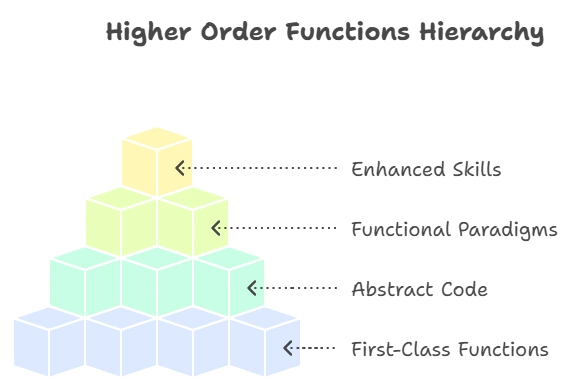Higher Order Functions
In Python programming, functions are more than just blocks of code to be executed. They can also be passed around as data, manipulated, and transformed. This concept lies at the heart of higher-order functions. Higher-order functions allow us to write more flexible, expressive, and concise code by treating functions as first-class citizens.
Introduction to Higher Order Functions:

In Python, functions are first-class citizens, which means they can be treated like any other object. This includes passing functions as arguments to other functions, returning functions from other functions, and storing functions in data structures.
First-Class Functions:
In Python, functions are treated as first-class citizens. This means they can be assigned to variables, passed as arguments to other functions, returned from other functions, and stored in data structures like lists or dictionaries.
Example:
def greet(name):
return f"Hello, {name}!"
greeting = greet
print(greeting("Alice")) # Output: Hello, Alice!
Higher Order Functions (HOFs):
- Higher order functions are functions that take other functions as arguments or return functions as results.
- They enable a functional programming style, allowing for concise and expressive code.
- Examples include
map(),filter(),reduce(), and custom functions designed to operate on other functions.
Exploring Higher Order Functions:
The map() Function:
The map() function applies a given function to each item of an iterable (e.g., list, tuple) and returns a new iterable with the results.
Example:
def square(x):
return x ** 2
numbers = [1, 2, 3, 4, 5]
squared_numbers = map(square, numbers)
print(list(squared_numbers)) # Output: [1, 4, 9, 16, 25]
Explanation:
- We define a function
square(x)that takes a numberxand returns its square. - We have a list of numbers
[1, 2, 3, 4, 5]. - We use the
map()function to apply thesquare()function to each element of thenumberslist. - The
map()function returns an iterator, so we convert it to a list to see the results. - Finally, we print the list of squared numbers.
The filter() Function:
The filter() function filters elements from an iterable for which a given function returns True.
Example:
def is_even(x):
return x % 2 == 0
numbers = [1, 2, 3, 4, 5]
even_numbers = filter(is_even, numbers)
print(list(even_numbers)) # Output: [2, 4]
Explanation:
- We define a function
is_even(x)that takes a numberxand returnsTrueif it’s even,Falseotherwise. - We have a list of numbers
[1, 2, 3, 4, 5]. - We use the
filter()function to filter out the even numbers from thenumberslist. - The
filter()function returns an iterator, so we convert it to a list to see the results. - Finally, we print the list of even numbers.
The reduce() Function:
- The
reduce()function applies a rolling computation to sequential pairs of values in an iterable, optionally with an initial value. - It’s available in the
functoolsmodule.
Example:
from functools import reduce
def add(x, y):
return x + y
numbers = [1, 2, 3, 4, 5]
total = reduce(add, numbers)
print(total) # Output: 15
Explanation:
- We import the
reduce()function from the functools module. - We define a function
add(x, y)that takes two numbersxandyand returns their sum. - We have a list of numbers
[1, 2, 3, 4, 5]. - We use the
reduce()function to apply theadd()function cumulatively to the elements of thenumberslist. - The
reduce()function returns a single value, which is the sum of all numbers in the list. - Finally, we print the sum of the numbers.
Advanced Concepts
Anonymous Functions (Lambda Functions):
- Lambda functions are small, anonymous functions defined using the
lambdakeyword. - They are often used as arguments to higher-order functions like
map()andfilter().
Example:
numbers = [1, 2, 3, 4, 5]
squared_numbers = map(lambda x: x ** 2, numbers)
print(list(squared_numbers)) # Output: [1, 4, 9, 16, 25]
Explanation:
- We have a list of numbers
[1, 2, 3, 4, 5]. - We use the
map()function with a lambda function to square each element of thenumberslist. - The lambda function
lambda x: x ** 2takes a single argumentxand returns its square. - The
map()function applies this lambda function to each element of thenumberslist. - Finally, we print the list of squared numbers.
Decorators:
- Decorators are functions that modify the behavior of other functions or methods.
- They are higher-order functions that take a function as an argument and return a new function.
Example:
def my_decorator(func):
def wrapper():
print("Something is happening before the function is called.")
func()
print("Something is happening after the function is called.")
return wrapper
@my_decorator
def say_hello():
print("Hello!")
say_hello()
In the above topic, we delved into the functools module in Python, which provides powerful tools for working with functions. We explored two key functionalities: partial() and wraps(). With partial(), we can create new functions with pre-defined default arguments, enabling code reusability and simplification. On the other hand, wraps() is invaluable when creating decorators. It preserves the metadata of the original function, ensuring that attributes such as __name__ and __doc__ are retained by the decorated function. Happy coding! ❤️
